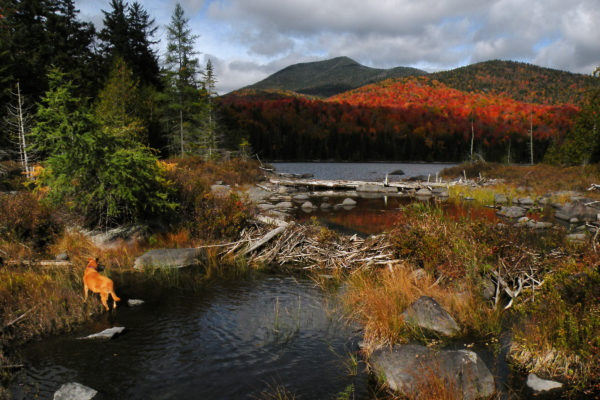Brook trout are a species of greatest conservation need in New York State and face challenges throughout their native range1. Intact stream populations of brook trout exist in only 9% of the subwatersheds within their native range in the US.2 Challenges to brook trout in the northern region of their range are sediment and high water temperatures, habitat fragmentation from dams and culverts, and non-native fish such as brown trout.3

On the Boreas Ponds tract the 28 mile road network bisects an even larger 59 mile stream network. These two networks meet at 27 locations, at which there is either a bridge or culvert that allows the road to pass over the stream. In at least a few cases the culverts are undersized, altering stream flow and blocking fish passage. An undersized culvert requires regular maintenance to clear blockages and avoid damage to the road. These culverts also prevent fish, such as brook trout, from moving upstream to find cool waters and spawn, resulting in reduced species richness and abundance4.

The Boreas Ponds tract falls within a high priority watershed for brook trout conservation.5 This indicates there are intact populations and a high probability they will remain if summer stream temperatures increase over the next several decades. High elevation areas with intact populations, such as the Boreas Ponds tract, offer our native cold water fishes the best opportunity for survival in a warming climate.1 But the cold headwaters streams found on the Boreas Ponds tract will serve little benefit to fish if they cannot access them due to culverts that block passage.
The Adirondack Park Agency and NYS Department of Environmental Conservation need to conduct further research to understand the brook trout and other fish populations, and the challenges facing them. Surveying culverts for ability to allow fish passage, fish population estimates in the streams and ponds, assessing recruitment from the streams to the ponds, monitoring water temperature, and analyzing the impact of removing the dams should all be completed as part of writing the Environmental Impact Statement for the various land classification alternatives.
A large, diverse network of waterways is present on the Boreas Ponds tract. The ponds offer habitat for large fish, the wetlands keep water temperatures cool and provide organic matter to the base of the aquatic food web, and high elevation upland streams feed clean cold water into the entire system. This is a near ideal situation for the conservation of brook trout, but currently the entire system is fragmented by the road network. Perhaps it is time to think beyond easy access to a nice view and consider the possibilities for ecological restoration on this tract of land. Let’s consider the value of conserving such an iconic species as brook trout and giving them the best chance possible to survive a warming climate. Closing a few miles of road is rather insignificant considering the many thousands of miles of road in the Adirondack Park. On the other hand, reconnecting such a large stream network would be a significant benefit to our cold water fish.
1 New York State Species of Greatest Conservation Need.
2 Hudley et al. 2005. Distribution, Status and Perturbations to Brook trout within the eastern United States. Eastern Brook Trout Join Venture.
3 Eastern Brook Trout: Roadmap to Restoration.
4 Nislow et al. 2011. Variation in local abundance and species richness of stream fishes in relation to dispersal barriers: implications for management and conservation. Freshwater Biology, 56: 2135-2144.



